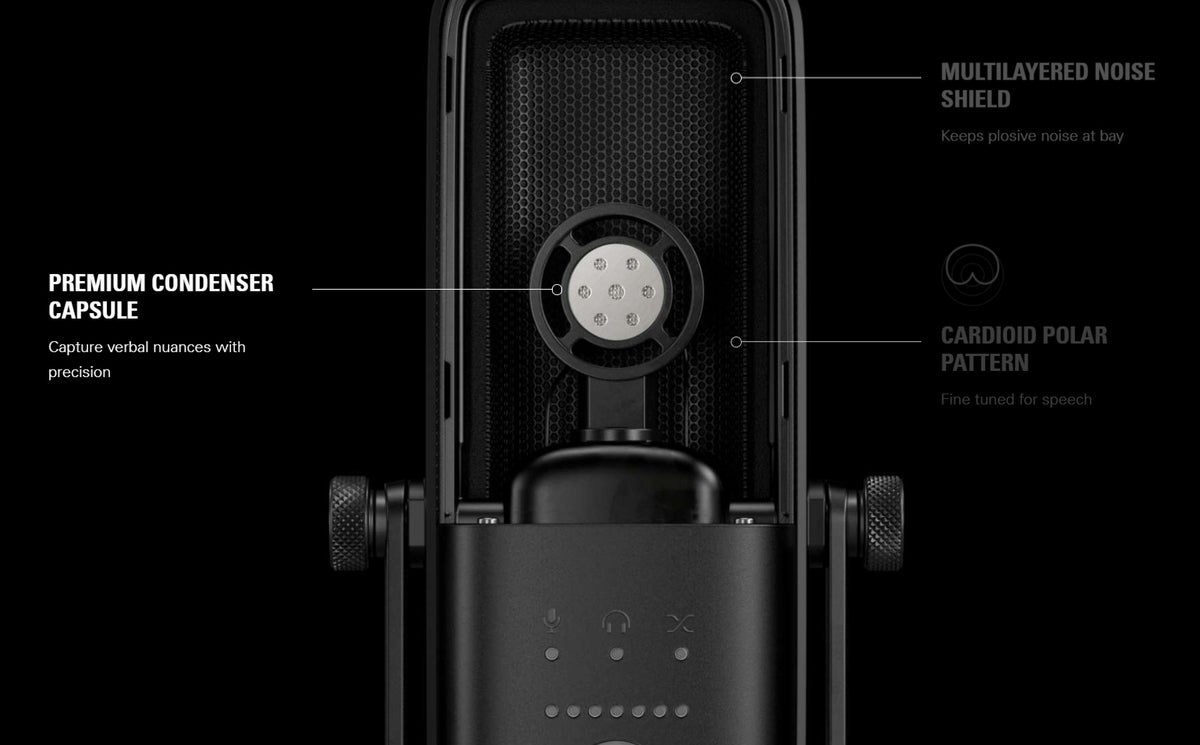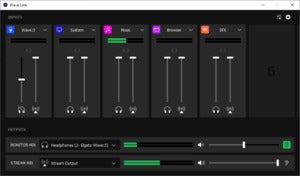
Rob Schultz / IDG
Whether you’re streaming games to Twitch, doing voiceovers for your YouTube videos, or just video chatting, your audience needs to be able to hear you clearly. If you’re still using microphones built into your laptop, webcam, or headset, it’s time to make an upgrade. These mics often produce weak audio and just don’t compare in sound quality to a proper full-size microphone.
Thankfully, you don’t have to blow your budget on pro-level audio equipment to significantly improve the quality of your voice chats and audio recordings. USB microphones are extremely affordable, easy to use, and provide great sound quality.
We’ve tested a lot of USB mics at PCWorld and have curated the mics that we’ve like the best below. When selecting our picks for the best USB microphones, we look for models that offer easy plug-and-play setup, great quality, and an affordable price. We also look for flexibility in audio settings that will work with different voice types and volumes. If you want to learn more about how to pick the best microphone for your particular needs, scroll down to our buyers’ guide below our recommendations, and check out our FAQ at the bottom for even more information.
The best USB microphones
Elgato Wave:3 – Our top pick

Pros
- Powerful and accurate audio
- Fantastic ADC
- Easy-to-use hardware controls
- Feature-rich software options
- Clean and sleek look
- Great value for the price
Cons
- Mic mute placement
- Included stand not usable for serious streamers
The Elgato Wave:3 packs in a lot of performance for a $160 USB microphone. Not only does it sound great out of the box, but it can be tuned further, too. You can also easily adjust the mic during streams, thanks to a capacitive mute button and a physical dial that controls mic gain, headphone volume, and crossfade (aka the balance of your mic versus PC volume when using connected headphones).
Powering the excellent audio is a 24-bit/96kHz analog-to-digital converter and a large condenser capsule sensitive to voices of all volumes, plus a lone cardioid polar pattern that keeps the focus on you and not background noises. Overall, voices sound natural coming through the Wave:3, and transitions from loud to quiet speaking are smooth. Our one nitpick is that this mic would sound even better with a little more sharpness in the mid-tones.
The Wave:3 also comes with built-in hardware to reduce unwanted vocal pops (those distracting bursts of air that happen when saying words that start with letters like “p” or “b”), as well as a unique feature that reduces clipping (the distortion that happens when you talk or yell louder than the mic can handle) by switching to a secondary signal that’s been picking up your voice at a lower volume.
Streamers with a two-PC streaming setup or the use of additional non-Elgato mics may need to look elsewhere, but for most people, the Wave:3 is the closest to a one-size-fits-all solution—especially since Elgato’s Wavelink software gives you control over audio routing of other sources beyond your mic, too.
Elgato Wave:1 – Runner-Up

Pros
- Same great sound profile as the Wave:3
- Same amazing software features
- Same clean and sleek look
- Easy-to-use mic mute
Cons
- Not a great value for its price
- Lacks dedicated mic gain/crossover control
- Lower-tier ADC compared to Wave:3
The Elgato Wave:1 may lack its sibling’s fancier features, but don’t count it out. It still has the same fantastic large condenser capsule and protection against plosives and clipping as the Wave:3, and you get similar sensitivity and tonal clarity, too. This mic plays nice with almost every voice out there—it provides warm, full tones in the low end that mix perfectly with a crisp high range.
Where it falls behind the Wave:3 is with its lower-quality analog-to-digital converter, which offers a 24-bit/48kHz signal. Less data in the digital capture of your voice means a less faithful reproduction of it, though as noted above, it still sound pretty good.
More disappointing are the stripped-down hardware controls. The control dial on the Wave:1 only toggles muting of the mic and headphone volume. You can still control mic gain and crossfade through Elgato’s Wavelink PC software, but the experience is more cumbersome than having dedicated controls on the mic. We think it worth the extra $30 to get a Wave:3, but if you’re on a tight budget, this $130 mic is still one of the best on the market.
Shure MV7 – Premium pick

Pros
- Inspired by a legendary microphone
- Rich, bright, radio sound
- USB/XLR connections
- Easy-to-use software
- Built like a tank
Cons
- Touch controls
- Requires more knowledge to use
- Micro-USB connection
- Steep price
Last fall, Shure released the MV7, a USB microphone inspired by the well-known audio company’s legendary SM7B—a professional microphone used for decades by vocalists and countless radio shows. But while still aimed at a more experienced user, the MV7 requires far less time to learn its ins and outs for the best possible experience.
And what an experience it is. This dynamic-capsule mic sounds fantastic in the lower range (think booming radio voice), with smooth, clearly defined reproduction of tones in the mid and high range, too. To get the best results, you’ll need to tweak the EQ settings using Shure’s easy-to-use MOTIV software, but you largely get similar performance to the unparalleled SM7B. Furthering the MV7’s professional vibe is its solid build quality, though its heavier weight and lack of included stand means you’ll need a strong boom arm to use it effectively. The MV7 is also compatible with XLR connections, so if you upgrade to a more high-end audio system in the future, you can do so without having to buy another mic.
The MV7 isn’t for everyone, however. Its dynamic capsule is better suited for a loud voice, and it also has a highly directional hyper cardioid polar pattern, which limits how you can use it. (Its position relative to your mouth strongly affects performance.) This mic’s signal also caps out at 24-bit/48kHz. Most disappointing is the touch panel interface on the device for mic gain control, mute button, and monitor levels, which can be awkward to use during streams. But if you’ve got the patience and the right kind of voice, it’ll make you sound like liquid gold.
Razer Seiren Elite – More affordable premium pick

Pros
- Low-end heavy, radio-like sound
- Simple controls
- Light-up compression warning
Cons
- No software tuning
- Micro-USB connection
Razer’s top offering boasts specs that put it on par with the best mics in this round-up. Like Shure’s MV7, the Razer Seiren Elite sports a dynamic capsule that works well with many vocal types, emphasizes low-end tones, and requires close proximity for smooth output. (That last aspect is a positive when in a noisy environment, as it keeps background noises from being picked up.) And like Elgato’s Wave:3, the Seiren Elite has easy-to-use physical controls, with one knob controlling mic gain, another controlling headphone volume, and a mute switch. It even features an LED ring around the base of the mesh grill that lights up to indicate when mic’s built-in compressor kicks in to even out high spikes in volume.
But while this compact mic generally takes a radio-like approach to mic design and sound signature, its $200 price tag drags down its appeal compared to our top pick, the $160 Wave:3. That’s particularly so with its analog-to-digital converter limited to a 16-bit/48 kHz signal—the baseline of usable signal by today’s standards. Other mics with higher bit rates will have a longer life as future standards (and audience expectations) rise. You won’t be able to tune its output further, either, as Razer’s Synapse app doesn’t support that—a real bummer, since Seiren Elite lacks the clarity and sharpness of other mics in the mid-to-higher frequencies necessary for that classic radio sound.
Blue Yeti X – Best multi-purpose option

Pros
- Simple and clean sound profile
- Sturdy build for mic and included stand
- Feature-rich software
- Multiple polar patterns make it versatile
Cons
- Sound lacks character
- Micro-USB connection
- Big and bulky
- Buggy software
Like Shure, Blue is a well-respected name in professional audio. But unlike Shure, Blue also has a history of producing great USB-based microphones for many use cases—and the company’s Yeti X comes closer to the Wave:3 in terms of audio performance than the rest.
Unlike the other mics on this list, though, the Yeti X doesn’t focus specifically on streamers. The company’s top microphone features multiple polar patterns (cardioid, omnidirectional, bidirectional, and stereo), which you can easily toggle through using the physical dial on the back. The condenser capsules in the Yeti X pick up voices easily and capture voice in all vocal ranges well, with an output at 24-bit/48kHz that has a neutral, more generic sound and works well for a variety of scenarios. That’s both a plus and a minus for this mic—with no features or distinct identity in its sound, it lacks a personality worth lavish praise. While you can tweak the audio profile in Blue’s Voice software quite a bit, the program can be buggy, making such adjustments unreliable.
Build quality is solid on this mic, which also comes with a heavy and sturdy included base. The main drawback of Yeti X’s design is how imposing it is in size—it takes up a lot of space within your field of view.
At $170, the Yeti X is the best Blue has to offer, but unless you’ll use your microphone for other purposes (in-person interviews, multi-singer recordings, etc.), you’ll be better off with a streaming-focused mic like the Wave:3.
Blue Yeti – Affordable alternative to the Yeti X

Pros
- Simple-and-clean sound profile
- Sturdy build for mic and included stand
- Multiple polar patterns make it versatile
- Feature-rich software
Cons
- Slightly oversensitive condenser
- Big and bulky
- Buggy software
Similar to its newer, higher-end sibling, Blue’s original Yeti model is a solid, all-purpose USB microphone that offers good sensitivity to a variety of voice types and clear, neutral sounding output. It also has excellent physical controls on the mic, with separate dials for headphone volume, polar pattern (cardioid, omnidirectional, bidirectional, and stereo), and gain level, plus a mute button.
As you’d expect, this signal produced by this baseline Yeti is stepped down (16-bit/48kHz versus the X model’s 24-bit/48kHz), but audio reproduction still sounds good. Its primary downside is just how sensitive its condenser capsule is—even in cardioid mode, the mic picks up background noises easily, including the sound of pressing the mute button. The Yeti also still sports the mini-USB connection that it launched with back in 2009, though arguably, mini-USB is a sturdier port type than micro-USB.
The included base is sturdy and heavy, though this mic benefits from being put on a boom arm. (Remember, it picks up background noise easily, so it’ll capture the sound of your keyboard and how it rattles on the desk with unfortunate clarity.) Positioning it can be a bit of a hassle, though, due to how the Yeti’s large size can block your view.
At a list price of $130, the Yeti is best for budget-minded people who will also use it for other purposes like multi-singer recordings and in-person interviews. However, if you can find it for a sale price of $85 (which the Yeti often dropped to before the pandemic), we’d consider it a solid budget mic.
Neat Bumblebee II – Budget alternative to the Yeti X
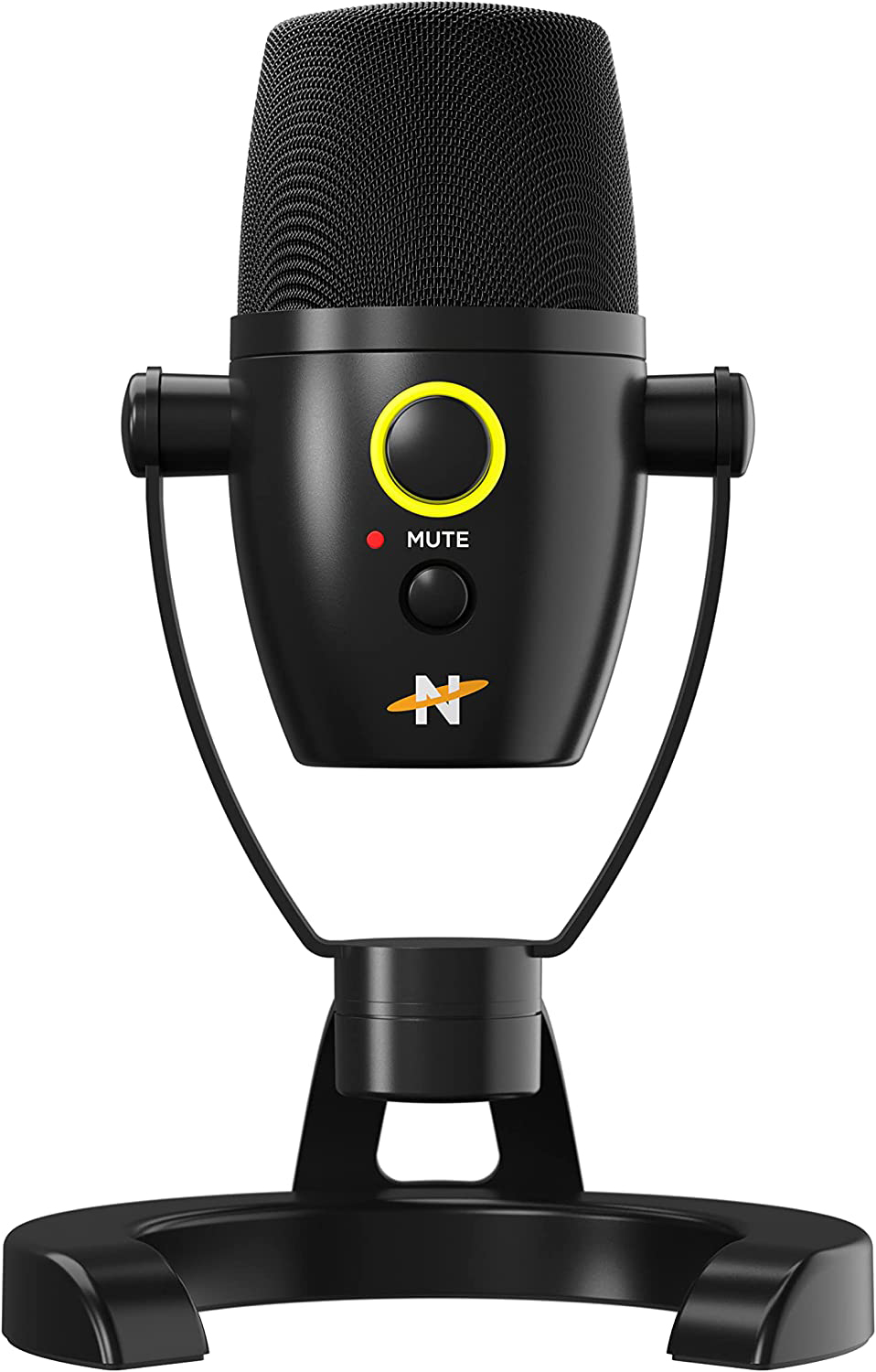
Pros
- Clean, neutral sound profile
- Solid base included with mic
- Affordable MSRP
- Excellent signal quality
Cons
- Very small mute indicator light
- Lack of control labels
- Mic picks up all clicking of control buttons
On the surface, the Neat Bumblebee II may seem like just another USB-C microphone, but it actually comes from a team that includes the original founders of Blue.
Despite that heritage, the Bumblebee II stands on its own. This $100 condenser mic offers good sensitivity and clear, neutral output. Recordings are clean and pleasant to listen to, with just enough warmth to prevent a sterile vibe—the sound is not as bright as with Blue mics.
Controls are straightforward, with one knob to control volume for a plugged-in headset, microphone gain, and the mix of sidetone and your PC’s output, and one dedicated mute button. A small red LED indicates your mute status. These physical controls feel good, but clicking them does get picked up by the mic. The mute indicator light is also quite small and hard to see at a glance.
Bumblebee II does offer just one polar pattern—cardioid, which picks up sounds only from the front of the mic. But it also provides excellent signal quality, with 24-bit/96kHz output. (Close rivals stop at a more modest 24-bit/48kHz [Blue Yeti Nano] and 16-bit/48kHz [Razer Seiren X]). It’s perfect for streamers and podcasters who don’t need multifunctionality and care more about faithful voice reproduction.
Support is scant for this microphone, so don’t lose your included quick start guide. Neat and parent-company Turtle Beach’s websites are both slim on documentation. There’s also no software for fine-tuning audio output. But for folks looking for a simple plug-and-play solution, the Bumblebee II does work extremely well out of the box.
Important features in a USB microphone
Capsule type
Capsules are pieces of hardware that converts sound-pressure levels traveling through the air (in this case, your voice) into a direct-current (DC) signal, aka the audio signal. How a capsule picks up audio signals is determined by its type. The two most common kinds you’ll encounter—and should seek out—are condenser and dynamic capsules.
- Condenser capsule microphones: This variety of mic uses extra voltage (+48V aka phantom power) to charge the capsule, which makes it more sensitive. Generally, condenser mics are better for people who speak at softer volumes or have voices with more dynamic range.
- Dynamic capsule microphones: Dynamic mics don’t require that extra voltage and are thus less sensitive. This sort of mic is better for people with loud voices or folks trying to better isolate audio pick-up to only what’s close to the microphone (i.e., trying to block out background noises like a mechanical keyboard or loud PC fan). Dynamic mics tend to last longer, as too much sensitivity can harm a capsule over time.
- Electret condenser capsules: This capsule type is cheap and small, and more often used in laptops and smartphones. Unlike a true condenser mic, electret condensers aren’t actively charged—instead, they essentially come pre-charged, so they’re lower power and produce lower-quality audio.
Digital signal quality (bit depth / sample rate)
After your voice has been transformed into an electrical signal by a microphone’s capsule, it then passes on to the analog-to-digital converter (ADC) found in all USB mics. As you might guess, the ADC converts the incoming analog signal (your voice) into a digital signal that your computer can use.
How accurately the ADC does so depends on its defined bit depth and sample rate. These two technical specs indicate how faithfully an audio signal replicates the original sound—in this case, the transmission of your voice through your mic to your PC. As the microphone transcodes your voice, it captures parts of the audio at specific intervals (sample rate) and a specific level of detail (bit depth) and then reconstructs the original based on that data.
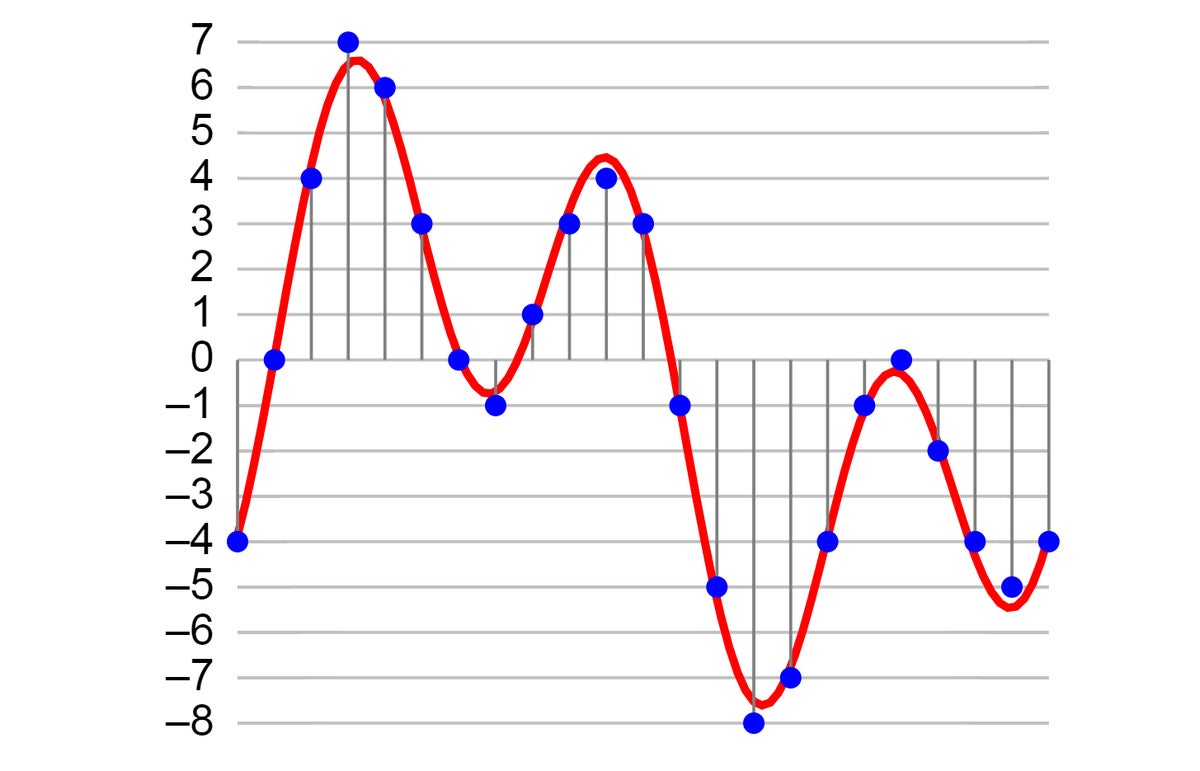
The digitization of an analog waveform involves two measurements: bit depth, which refers to the amount of amplitude samples available, and sample rate, which refers to the amount of samples per second (measured in Hz) available. More bit-depth samples mean more dynamic range, while more sample-rate samples mean more granularity between frequencies.
The higher the number of both bit depth and sample rate, generally the more faithful the reproduction. Other factors, such as the condenser type and how the microphone is tuned, also influence what you actually hear as the end result, but because bit-rate and sample-rate numbers reveal the amount of data captured and kept for use, they can serve as a quick way to screen for anything underpowered. A low bit depth and sample rate results in a voice that sounds digital and robotic—the signal lacks enough detail to keep all the nuance and personality of the original speaker—so avoid microphones that are stingy in this regard.
Consider a 16-bit/48kHz signal a minimum (it’s roughly the level of a CD in quality), and aim for higher to prolong the use of your microphone. Like with photos and video, standards gradually climb over time, and so too audience expectations for quality.
Sensitivity
The sensitivity of a mic indicates how easily it picks up sound. If you have a quieter voice, seek out a more sensitive microphone for more accurate reproduction of your voice—conversely, if you have a booming voice, you’ll need a less sensitive microphone for the same effect. Condenser types (see above) influence how sensitive a mic is, as does the ability to tweak the gain level.
Mic controls
Touch-based controls might be popular for some microphones, but physical controls like buttons, knobs, and dials are superior: No looking is necessary when making on-the-fly adjustments during streams—you can keep your eyes on your screen while fiddling. Better microphones offer control over mute, gain level, and headphone volume (if you can plug in headphones directly into the mic) at minimum. We like to see crossfade (the balance between your PC’s audio and hearing your own voice fed in from the mic) as an option, too.
Software controls
For a USB microphone, you’ll do all your audio processing—that is, tweaking the audio that comes through the mic—in a desktop PC program. Ideally, this companion software should be easy to use, easy to navigate, and allow you to tune the audio output. The best software also lets you configure the routing of other audio sources (e.g., the game, chat from programs like Discord, and music from Spotify). You can choose what gets pulled in and how that’s directed out.
Build quality
The build quality of a microphone affects more than just how the device holds up with use—it also has an impact on audio performance. The better the materials, the better quality of vocal performance. The capsule type, housing around it, and any shielding placed between you and the capsule (to tamp down unwanted noises) all influence the mic’s output.
Type of USB connection
Micro-USB is still surprisingly common among USB microphones, despite the growing adoption of USB-C and its advantages. We prefer a USB-C connection for its better durability, both for the port itself and for cables—anecdotally, we’ve had more micro-USB ports and cables fail or loosen over time.
That said, micro-USB should still serve fine, especially if you don’t plan to move your microphone around (a potential source of stress on the port) or regularly plug and unplug the cable.
Polar pattern
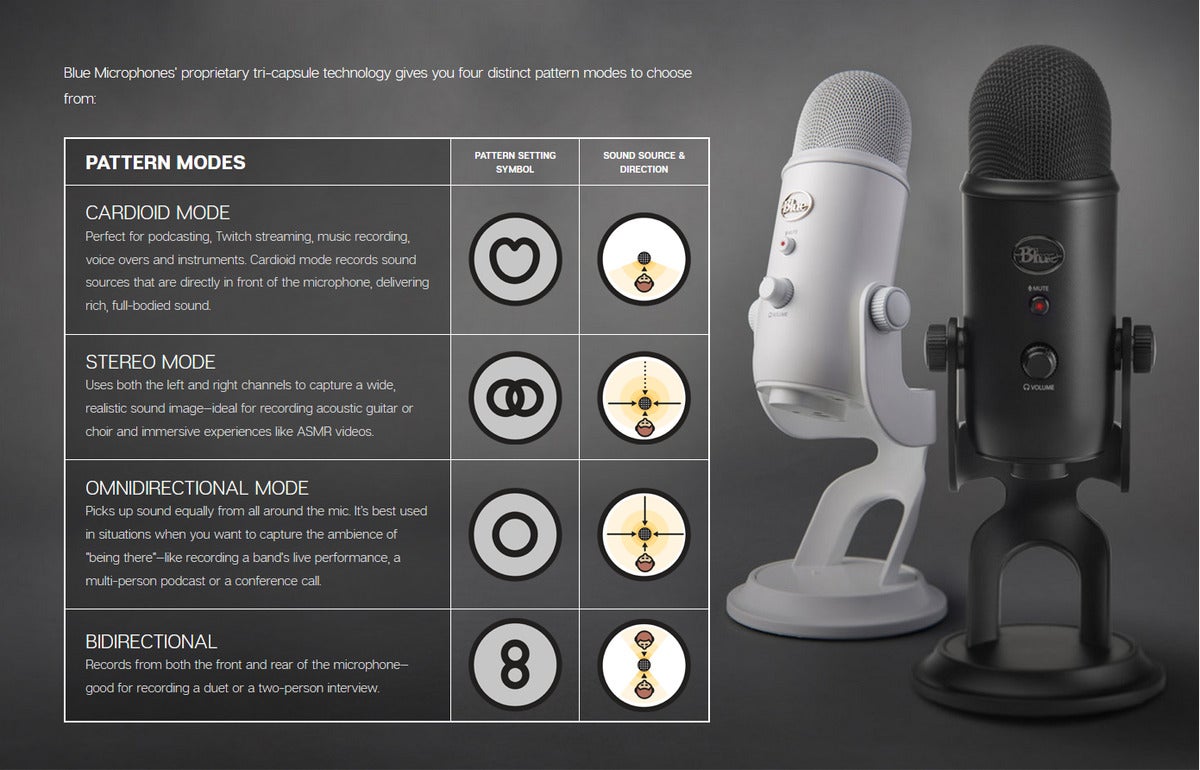
This screenshot from the Blue Yeti product page illustrates which parts of the mic are active for each polar pattern supported.
A polar pattern (or pick-up pattern) indicates the areas of a mic that are sensitive to sound. Streamers should focus on microphones with a cardioid pattern, which makes the mic more sensitive right in front of the capsule (typically the top of the mic) and less so on the sides and rear. This type of polar pattern helps physically isolate the audio source being recorded—in this case, you.
Some mics feature other polar patterns as well, making them more versatile for use. Other common ones are omnidirectional, which makes the mic sensitive to pick up on all sides (useful for conference calls); bidirectional, which picks up from the front and and rear (useful for face-to-face conversations between two people); and stereo, aka mid-side, which makes the mic pick up the right and left channel separately while being sensitive at the front (useful for multiple people conversing or singing while sitting side-by-side and all facing the mic).
What to look for
Our picks for best USB microphones work well with a wide variety of voices, but to find a mic that fits your voice just that much more, keep these factors in mind.
Tonal reproduction
Tonal reproduction refers to how close the microphone’s output matches the sound of a person’s actual voice. Some microphones cater to lower-end vocal ranges by doing things like boosting mid-range frequencies, while others cater to those with higher pitches by having a less sensitive capsule. To get your desired style of output, find out how a microphone is tuned, plus the size of capsule in the mic and the type of mic. These add up to form the microphone’s profile—and once you know it, it’s pretty easy to narrow the field of mics that are right for you.
Vocal clarity
Vocal clarity refers to how loud and clear someone can be heard with a microphone. While tone can certainly play a part in this, the biggest influences on clarity are how sensitive the microphone is to the audio it’s receiving and how strong the amplification process is in translating that to a digital signal. A quiet voice will need both a more sensitive microphone and stronger amplification in order to achieve desired volume levels, while a big, booming voice will need the opposite. (In fact, if a highly sensitive microphone is regularly subjected to loud sounds, it can actually damage the capsule over time.)
The distance from you to the microphone has an impact on this as well, but we don’t recommend shifting your position to make a mic work with your voice. Generally, you want to have a microphone as close as possible to your mouth, as that’s the position for getting its best performance.
Analog-to-digital converter quality
As mentioned above, when you speak into a mic, that analog signal gets captured by the microphone’s capsule, then an analog-to-digital converter (ADC) transcodes that to a digital signal that your computer can use. How good an ADC is will impact both the tone reproduction and clarity of the digital output, as well as how loud it is. Output from low-quality ADCs sound less natural and can even have more digital artifacts, resulting in a tinny sound with less range. An ADC can also affect the signal transmitted to your PC by not providing enough power to the output of the audio, resulting in less clarity and a quieter volume to work with.
Think of an ADC like the middle person in a three-person game of Telephone—it has the ability to dramatically convolute or distort what the original person passed on. Generally, the better the converter, the more the voices of all types benefit from accurate reproduction, but some folks with specific voice concerns (like quiet volume or a thinner sound) might need to pay more attention to specs like bit depth/sample rate, which influence how strong a signal the ADC sends to your PC.
Once you’ve narrowed down your potential microphone picks, find videos of them in use to get a better sense of how their output sounds. As a starting point, we’ve used all of these microphones in this roundup in our live videos on YouTube and Twitch.
USB microphone vs. a headset
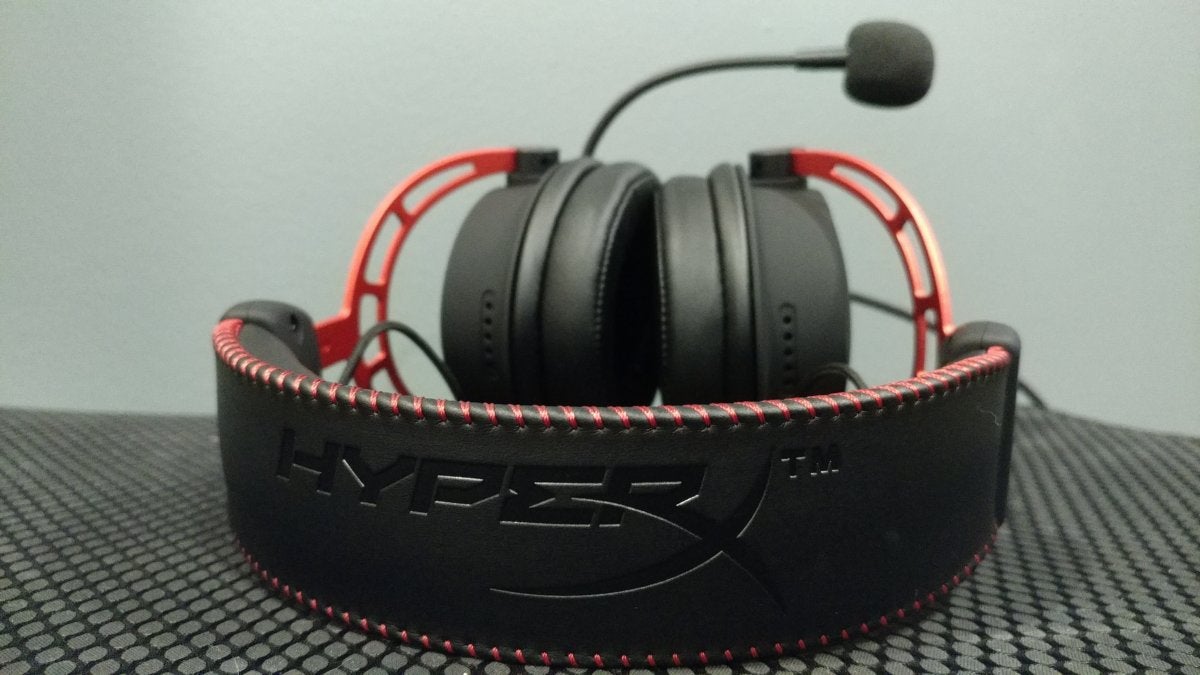
Good headsets sound decent on a stream, but a dedicated USB microphone provide the clarity and warmth that draws in viewers. Here’s why.
While USB microphones are cheaper than a full professional setup, they’re pricier than a good headset. Even headsets that cost about the same may still seem more appealing, since you can use a headset for both listening and talking.
So why choose a USB microphone instead of a headset? While headsets don’t sound bad on a stream, a headset microphone is just too small to really compete with a USB mic. Generally, the larger the capsule, the more sensitive a microphone can be to sound pressure changes, thus producing more accurate results.
That’s the reason headset microphones struggle to produce a well-rounded sound, especially in the low end. Short of attaching a huge capsule to a boom arm on a headset, a standalone USB mic will be better suited for professional-sounding streams. And the more you sound like you could be in the same room as your viewers, the more likely they’ll connect with you and stick around.
FAQ
1.
Is a USB or Aux mic better?
This largely depends on what your intended use for the mic will be. Auxiliary mics, which use the 3.5mm audio jack, typically have a higher sound fidelity, allowing for clearer and crisper output while recording. This is especially true for live audio such as music recording with instruments. However, 3.5mm mics are usually more expensive and have a tendency to produce static as they age or as a result of wiring and connection issues.
USB mics are cheaper and they are easy to use. They don’t require any additional equipment for recording either. As technology progresses, USB mics are not only going to remain inexpensive, but their audio quality will continue to improve as well.
If you are a beginner or on a budget, then you will want to go with a USB mic as they will be more affordable and you probably won’t notice much of a difference in the audio quality anyways. However, for true audiophiles or professional recording artists, a 3.5mm mic is still likely to be preferrable.
2.
Can you use a USB mic without headphones?
A USB microphone is a standalone mic that only picks up audio input. It does not include speakers for audio output and therefore you will need headphones or separate speakers in order to hear audio that the mic is recording.
3.
How do I get rid of background noise on my USB mic?
If your mic is picking up background noise then there are a few solutions you can try to reduce those unwanted sounds.
Most USB mics nowadays allow you to control the level of background noise that your device picks up. This can be done either through the sound options on your computer or, depending on the device, the software you installed to set up the mic itself.
Additionally, you can purchase things such as shock mounts for your mic stand that reduce tremors and vibrations, or wind shields that cut out wind or heavy breathing interference.



